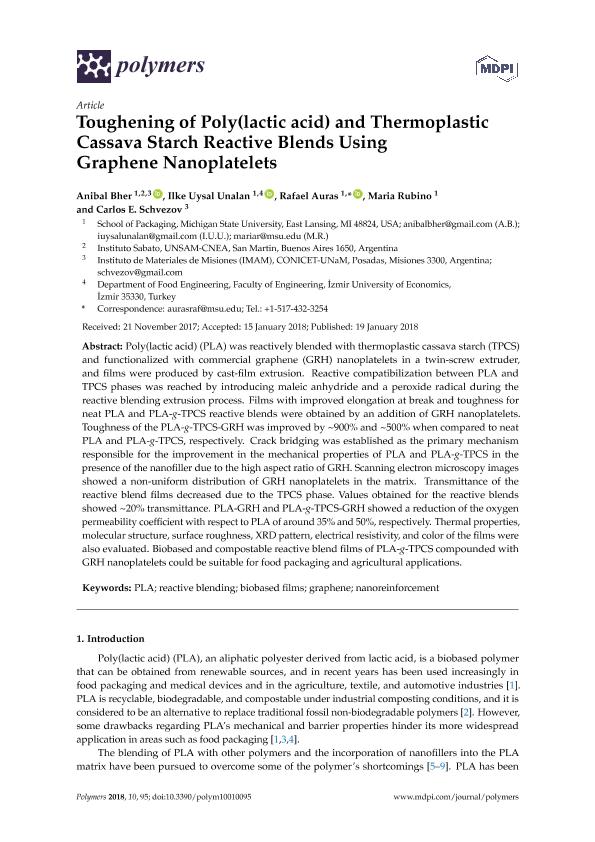Artículo
Toughening of poly(lactic acid) and thermoplastic cassava starch reactive blends using graphene nanoplatelets
Fecha de publicación:
01/2018
Editorial:
Molecular Diversity Preservation International
Revista:
Polymers
ISSN:
2073-4360
e-ISSN:
2073-4360
Idioma:
Inglés
Tipo de recurso:
Artículo publicado
Clasificación temática:
Resumen
Poly(lactic acid) (PLA) was reactively blended with thermoplastic cassava starch (TPCS) and functionalized with commercial graphene (GRH) nanoplatelets in a twin-screw extruder, and films were produced by cast-film extrusion. Reactive compatibilization between PLA and TPCS phases was reached by introducing maleic anhydride and a peroxide radical during the reactive blending extrusion process. Films with improved elongation at break and toughness for neat PLA and PLA-g-TPCS reactive blends were obtained by an addition of GRH nanoplatelets. Toughness of the PLA-g-TPCS-GRH was improved by ~900% and ~500% when compared to neat PLA and PLA-g-TPCS, respectively. Crack bridging was established as the primary mechanism responsible for the improvement in the mechanical properties of PLA and PLA-g-TPCS in the presence of the nanofiller due to the high aspect ratio of GRH. Scanning electron microscopy images showed a non-uniform distribution of GRH nanoplatelets in the matrix. Transmittance of the reactive blend films decreased due to the TPCS phase. Values obtained for the reactive blends showed ~20% transmittance. PLA-GRH and PLA-g-TPCS-GRH showed a reduction of the oxygen permeability coefficient with respect to PLA of around 35% and 50%, respectively. Thermal properties, molecular structure, surface roughness, XRD pattern, electrical resistivity, and color of the films were also evaluated. Biobased and compostable reactive blend films of PLA-g-TPCS compounded with GRH nanoplatelets could be suitable for food packaging and agricultural applications.
Palabras clave:
BIOBASED FILMS
,
GRAPHENE
,
NANOREINFORCEMENT
,
PLA
,
REACTIVE BLENDING
Archivos asociados
Licencia
Identificadores
Colecciones
Articulos(IMAM)
Articulos de INST.DE MATERIALES DE MISIONES
Articulos de INST.DE MATERIALES DE MISIONES
Citación
Bher, Anibal Ricardo; Unalan, Ilke Uysal; Auras, Rafael; Rubino, Maria; Schvezov, Carlos Enrique; Toughening of poly(lactic acid) and thermoplastic cassava starch reactive blends using graphene nanoplatelets; Molecular Diversity Preservation International; Polymers; 10; 1; 1-2018; 1-18
Compartir
Altmétricas




